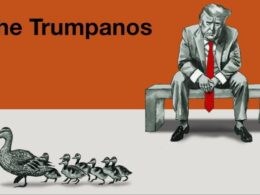Unlock the White House Watch newsletter for free
Your guide to what the 2024 US election means for Washington and the world
The writer is a longtime Silicon Valley investor
There is one notable thing lacking in Donald Trump’s declaration of economic and diplomatic war on the world — a strategy for winning. To many in Silicon Valley, where science and reason are cherished, the chaos that followed the president’s unleashing of “reciprocal” tariffs has looked like an act of self-harm.
Fifteen years ago, the late Andy Grove, the chief executive who led Intel to glory, began sounding the alarm about the absence of a rounded US economic policy. Grove, born into a Jewish family in Budapest and the survivor of the depredations of two despots (Hitler and Stalin), knew all too well the perils of centralised planning.
He wasn’t bashful about advocating an approach to national economic policy that included tariffs. But it came with a proviso: if the US was going to resort to tariffs, he wanted to be sure his adopted country would win. Instead, the current administration’s playbook will only make China stronger.
It seems likely that Grove would have advised the Republicans to isolate one country and rally allies. He would have insisted on a road map for what should be made in America by 2035 and which technologies the country should seek to dominate. And he would have demanded that Trump and his supporters confront a set of issues that go deeper than the layout of global supply chains, including educating the young, taking care of the sick and tending to the aged at home.
In Grove’s view, government plays a vital role in developing a robust national infrastructure, funding basic research and making the US a beacon for immigrants. He also believed it was vital for the country to maintain a thriving manufacturing base.
Since the 1970s, China and countries in south-east Asia have perfected a formidable triple axle comprised of the command of raw materials, mastery of component manufacturing and packaging, and now — by dint of drive, creativity and a formidably well-educated cadre of scientists and engineers — an array of products that put the west to shame.
Just look at the manufacturing knowhow of Foxconn and TSMC and the product line-up of companies such as Huawei, BYD and Xiaomi — the last of which is only 15 years old. They are enough to make Americans weep. And that’s before you calculate the size of their workforces or contemplate that about 450,000 cars were built in China in 1987 compared with 31mn in 2024.
The only scalers remaining in America are the so called “hyper scalers” — the large technology companies. But they grow by stuffing servers into data centres, not by hiring millions of employees. Back in 2010, Grove had an idea for modifying this impulse. He wanted to create a “scaling bank of the US” (not to be confused with a sovereign wealth fund) which would use all revenues derived from tariffs to support companies that scaled their factories and workforces in America.
Grove, himself a brilliant scientist, would be alarmed by the rate at which Chinese universities produce physicists, chemists, biologists and mathematicians compared to their US counterparts. This gap will prove even deadlier if the brightest young things are forbidden from studying and settling in the US. It’s simple: scientific knowledge leads to progress and the competition between young scientists in China leaves the west in the dust. Stay tuned for the decimation of the US biotechnology industry by hundreds of Chinese start-ups staffed with young graduates.
As Republicans celebrated the dismantling of the US education department, it was shocking that they failed to demand stringent literacy targets from the individual states. Just as dismaying is the way they have used antisemitism as a smokescreen to employ scorched earth tactics against universities and research institutes, while belittling the contribution of immigrants. If research is targeted, books are likely to be next.
Republicans have chosen to ignore the effect of rising healthcare and pension costs on US competitiveness. Consider this: since Grove’s early years at Intel, manufacturing’s share of GDP declined from about 21-25 per cent to about 10 per cent. Meanwhile, healthcare represents about 17 per cent of the US economy compared with 5 per cent of GDP in 1960.
Declining education standards, rising healthcare costs, spending on retirees, interest payments on the national debt — think of them as our self-imposed (and poorly policed) domestic tariffs. Since so-called liberation day, nary a word has been said about them. This omission is even more depressing than the improvised brutality and uncertainty of the past couple of weeks. Grove would have been appalled.
Source link









